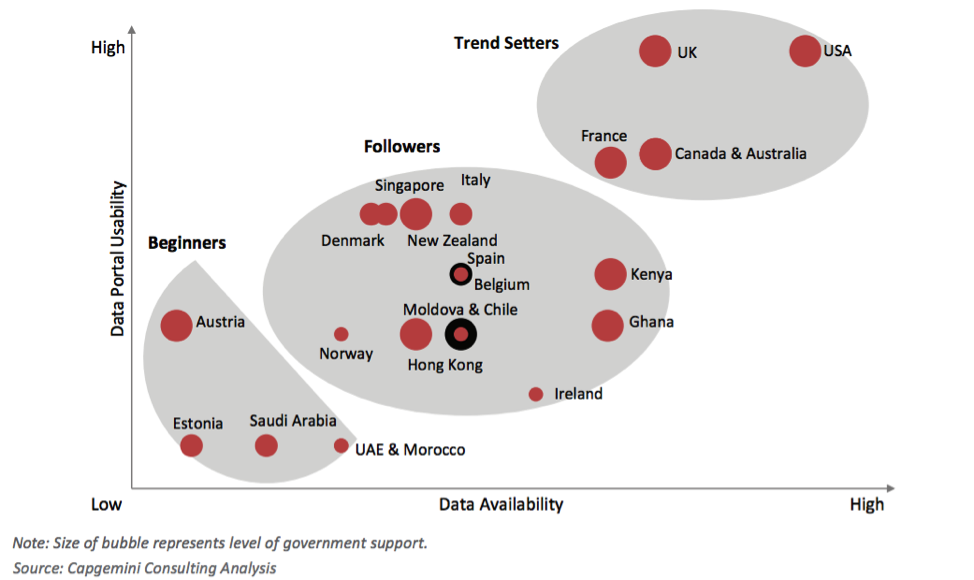How open data portals can drive economic growth and innovation
- Transfer

Government bodies not only hide a tremendous amount of information, but also create a huge amount of data. Actually, they are one of the largest data sources in the world, the source materials that they have can cost a lot of money. According to McKinsey's 2011 forecast , by 2020, the potential value of Big Data for the European sector could increase to two hundred and fifty billion euros per year. Most of this data is generated on budgetary funds, therefore, it would be logical to provide them for public use. This would allow people to create new innovative services that could have a significant impact on economic growth.
Many governments are aiming to open their data. The European Union is working on creating regulatory requirements for declassifying data held by European Union institutions, and the US government has developed a data disclosure project, which was launched in 2011. In addition, the Australian government has developed an extensive strategy , the main purpose of which is the publication of data owned by national or regional authorities. With this strategy, the Australian government wants to ensure that authorities and organizations take full advantage of Big Data, while ensuring confidentiality. Of course, there are many other countries in the Open Data Economy reportCapgemini Consulting explains that, regarding the issue of publishing data, countries can be divided into three different categories: beginners, followers, and trend-setting. 23 countries were analyzed, and it is now known that 22% of countries shared data that can be defined as complex data containing high-value information, but too detailed in nature, and also including a large number of disparate data sets, so that there is still a lot of work.

Circumference shows state support
One of the promising areas of activity that has arisen due to the fact that governments are notifying the public about the publication of data is an upsurge in the field of data trade or in information markets. A large number of new companies create trading platforms where not only public information is available, but where users are also given the opportunity to easily combine it with all kinds of other (freely available) databases to develop original ideas and explore new perspectives that open up when different sets interact. data. Such data markets are becoming increasingly important, and, fortunately, are developing quite quickly, judging by the list , which includes 17 different data markets.
Information can be published, sold, bought, distributed or made available for free download through portals that offer great opportunities for countries, companies and young firms around the world. Neelie Kroes , vice president of the European Commission, believes that declassifying data can double its value to about seventy million euros. Subsequently, such portals can be used to create applications that can help improve society, solve economic problems and contribute to its growth.
There are many benefits to both the state and entrepreneurs. According to Capgemini's report, open data portals can manage revenue, reduce costs, increase efficiency and create jobs for future generations. The state, for example, can increase tax revenues, while providing increased economic activity or make money by selling the accumulated information of high value at inflated cost. Although, of course, it can be argued that raw material, when published, should be sold free of charge or at cost, and pre-processed data can be sold at a premium. From the report:“In countries where organizations have minimized / zero the pricing model of charges for the service, the number of new users who have come back has increased and ranges from 1,000% to 10,000%, which leads to higher revenues . ”
If different data sets interact with each other and are also associated with proprietary / corporate information, this can lead the company to increase efficiency, the emergence of new ideas and more rational decision-making, as she will have more prospects in the market. And finally, the benefit that arouses interest during the crisis provides a revitalization of entrepreneurial activity, which, in turn, leads to an increase in the number of jobs and the need for more qualified employees (which entails the introduction of new, including distance, training courses in universities).
There are many examples in the world of how information from open data portals helped find original solutions to many different problems. The OpenData500 website has compiled a long list of startups working with Big Data and using open sources of materials in order to build and develop their companies. In addition, several projects from the Open Data Institute (UK) also joined the program . Let's look at three of them:
- Company BillGuard analyzes available data on court proceedings relating to matters accrual accounts, in order to identify financial fraud.
- Placr is creating a unified resource of information for developers about public transport, including a timetable, real-time transport departures, and other crucial information collected from open data resources.
- Owler is a mobile online resource that provides competitive intelligence reports, thereby helping the user to follow and monitor companies, as well as get complete information about them.
There are many more companies working hard to learn how to use Big Data to create such projects and solutions. Of course, this will become possible only when they have access to information, and this, in turn, reflects the potential of disclosing databases and creating open data portals. Fortunately, some governments, among other things, create variations on the topic of such projects, by materially supporting the most innovative applications based on open data. A striking example is the competition from the American Energy Data Challenge, where one hundred thousand dollars is offered to the most innovative company, which will increase energy efficiency and offer clean energy generation technologies using publicly available information. Such incentives combined with a large number of open data portals will ensure the growth of innovation and the economy.
